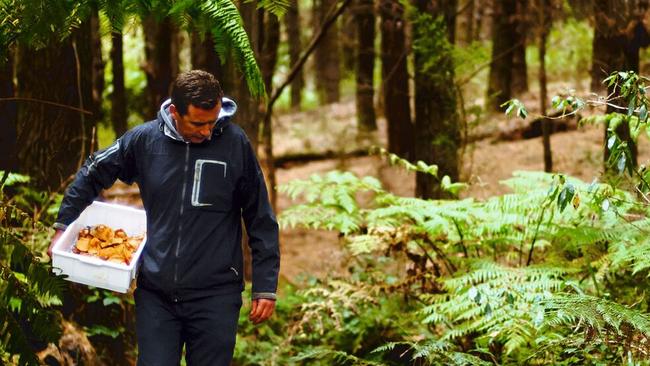Brae’s Dan Hunter reveals his secrets
Chef Dan Hunter’s vision of what he wanted a restaurant to be — a ‘productive restaurant utopia’ — has paid off.

Dan Hunter is leading us around his veggie patch in regional Victoria and talking about yam daisy, one of several native plants growing on this 12ha property in the bush. With its bright yellow flowers, murnong — its other name — is often mistaken for a dandelion. But tastier.
“I’m interested to see how it goes,” the chef says. “Yam daisy was a staple food source for indigenous Australians in southeastern Australia, but the sheep ate it almost to extinction. So it’s nice to see it coming back.”
A short stroll away, in the quietly stylish farmhouse dining room that is Brae, diners from all corners of the globe are starting their lunch, perhaps with a slice of raw pea and lemon aspen tart, or some sashimi-grade prawns with nasturtium and finger lime. And someday soon the menu may well include a dish incorporating yam daisy, at this stage still an experimental crop.
Once, eating off the land in Australia meant lamb chops twice a day. But that was before the advent of celebrity chefs; before the notion of destination dining had any relevance beyond the big cities; and before the rise of a global collective of eco-aware superchefs for whom going hyper-local and growing their own ingredients came as naturally as refining a sauce for a high-end degustation dinner.
For Hunter, whose 50-seater in the Otways hinterland has just been placed at No 44 on the World’s 50 Best Restaurants List, announced in Melbourne this month, the pay-off of such dazzling recognition is the chance to continue working the land his way; a very enlightened way, for an elite audience happy to pay $240 a head for the privilege (plus wines).
As the chef writes in his new book, Brae: Recipes and Stories from the Restaurant, it took him almost four years to find the site that lived up to his “very clear vision” of what he wanted a restaurant to be.
That vision was for an “immersive experience”, a 21st-century realisation of the Australian rural idyll, where he could create “a kind of productive restaurant utopia”.
If that all sounds rather highfalutin, then you need to turn to the first chapter, Road to Brae (yes, there are 80 pages of text before you get to the first recipe), where Hunter tells a raw, candid tale of his journey from dishwasher to chef and the big job at Mugaritz and beyond, including an amusing anecdote about doing a quick “apprenticeship” in the library at Bath.
Brae is only nominally a cookbook. Yes, there are recipes — beautifully photographed in fittingly understated style by Colin Page — but they are recipes for boggling at, not cooking, unless you fancy fermenting a few roots before combining the charred carrot with the smoked oil and gellan gum and … yeah, right.
Two years in the writing, and at 85,000 words (including the recipes, which are all rather long), Brae came in one year overdue, but the timing, coinciding as it did with the 50 Best triumph, couldn’t have been better.
Now, it’s even harder to get into the little restaurant in Birregurra. Saturdays are booked until September, and staff report a sevenfold increase in bookings since the awards were announced on April 5.
Back in the garden, Hunter is fielding the usual question about the role of high-profile chefs in defining Australian cuisine today.
“Well, we just cook what we know,” he says, referring also to Attica’s Ben Shewry and Quay’s Peter Gilmore. “We don’t think, let’s create an Australian cuisine … It’s just the multicultural food we grew up with.
“It’s our food.”
Brae: Recipes and Stories from the Restaurant, by Dan Hunter, will be published by Phaidon on May 1 ($75).
